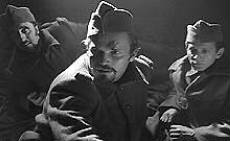In For the Long Take
Rob over at A Film Odyssey is trying to get discussion going on the extended take. Certainly a noble effort, so I'll do my best to add to the conversation.
The first extended take I ever really noticed wasn't even all that extended. It was maybe 5 seconds, and in most every sort of movie out there, that's nothing. But this was a battle scene. Bombs falling all around, chaos on screen. And yet the camera didn't constantly jump around, giving close-ups of the dead bodies and those who are still attacking. No, Paths of Glory stuck with its relatively long shots of Kirk Douglas advancing with his troops. Even the cuts didn't significantly change the camera position. Funnily enough, before I rewatched the film for this, I thought the battle was in one continuous take. The camera is always slowly tracking to the left, and the cuts seem so insignificant that it's almost like it is one shot, showing the true horrors of war.
But these aren't the real long shots in Paths of Glory, and those are just as interesting if not more. For the bulk of my discussion on the long takes, I'm going to focus on two particular long shots which, in effect, serve the same thematic purpose.
The first shot follows General Paul Mireau (George Macready) as he walks through the trenches to rouse the troops' spirits so they will be ready for battle. The shot follows him from when he enters th
 e trench, watching him talk to soldiers. He asks them if they're ready to kill for their country and if they have wives that are proud of them. Mireau looks cool, calm, and collected as he encourages the troops. At this point, he looks like a good general, and it is the long shot that shows it about them. But the long shot does not last forever. Mireau comes upon a man (Fred Bell) who barely comprehends his questions. We finally get the first cut in the sequence to the man's face. A fellow soldier informs Mireau that the man is shell-shocked, to which Mireau angrily responds, "there is no such thing as shell-shocked." Suddenly, with this cut, Mireau is no longer the reasonable general he seems a moment ago. But this is the real General Mireau, the one we did not see in the single take.
e trench, watching him talk to soldiers. He asks them if they're ready to kill for their country and if they have wives that are proud of them. Mireau looks cool, calm, and collected as he encourages the troops. At this point, he looks like a good general, and it is the long shot that shows it about them. But the long shot does not last forever. Mireau comes upon a man (Fred Bell) who barely comprehends his questions. We finally get the first cut in the sequence to the man's face. A fellow soldier informs Mireau that the man is shell-shocked, to which Mireau angrily responds, "there is no such thing as shell-shocked." Suddenly, with this cut, Mireau is no longer the reasonable general he seems a moment ago. But this is the real General Mireau, the one we did not see in the single take.This structure is echoed later in the film, as the three soldiers picked for their deaths (Timothy Carey, Joseph Turkel, and Ralph Meeker) tell their stories to Colonel Dax (Kirk Do
 uglas. This first real introduction to the characters (each of them was around when General Mireau interviewed soldiers) is shown in one fluid take, showing their innocence. They haven't done anything wrong, and as such, they are shown without a cut. But like General Mireau, they cannot be shown without a cut forever. This time, their scene is shown in one take, and the cut is to another part of the story. But when we return, we again see that the cut shows us their true characters. Corporal Paris (Meeker) and Private Ferol (Carey) are shown to be "cowards" because they greatly fear death. And Private Arnaud (Turkel) is nothing but a bully.
uglas. This first real introduction to the characters (each of them was around when General Mireau interviewed soldiers) is shown in one fluid take, showing their innocence. They haven't done anything wrong, and as such, they are shown without a cut. But like General Mireau, they cannot be shown without a cut forever. This time, their scene is shown in one take, and the cut is to another part of the story. But when we return, we again see that the cut shows us their true characters. Corporal Paris (Meeker) and Private Ferol (Carey) are shown to be "cowards" because they greatly fear death. And Private Arnaud (Turkel) is nothing but a bully.Jean-Luc Godard once famously said "Cinema is truth at twenty-four frames a second. Every edit is a lie." With Paths of Glory, Stanley Kubrick provides a stark counterexample, showing each man's true nature only through the cut. Every long shot is merely artifice, a show. Kubrick uses this point to show how within the show, each character is a show. They put up a front, but their true form can only be shown once the artifice has been taken away, when the long shot has been cut.


0 Comments:
Post a Comment
Subscribe to Post Comments [Atom]
<< Home